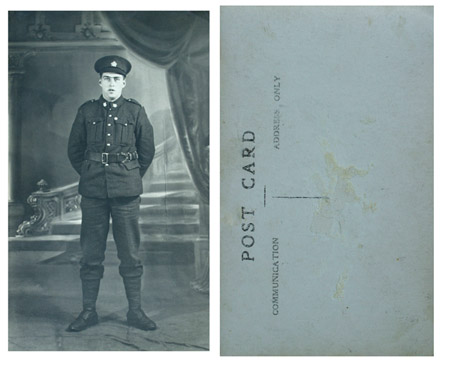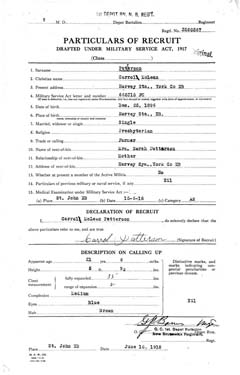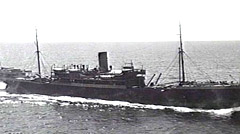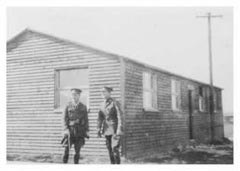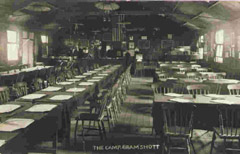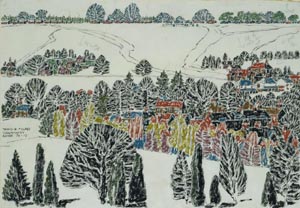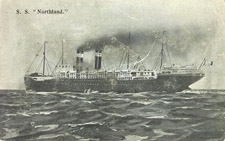

Return to genealogical entry for Carl Patterson
Descendents of William James Patterson (6 Mar 1812 - 11 Dec 1892)
and Sarah Ann Jane Dibblee (3 May 1820- 8 Nov 1855)Private Carroll "Carl" MacLean Patterson, Canadian Expeditionary Force
(Regimental Number 3260367)
RG 150 Assession 92-93/166 Box 7636.
Medium sized pop up image
700 X 582, 72 dpi, 108 kFull sized pop up image
2448 X 2034, 180 dpi, 2676 k
Medium sized pop up image
Photo Only
700 X 1183, 72 dpi, 181 kFull sized pop up image
Photo Only
1096 X 1852, 180 dpi, 1258 kCarroll Patterson in photo taken in late 1918 - early 1919 in England. Source: original postcard image in possession of his daughter Irene Findlay, Riverview, N.B. rephotographed by Tim Patterson, July, 2006.
As World War I wore on Canadian losses in the field began to outstrip voluntary recruitment efforts. Despite considerable opposition from some quarters, particularly in Quebec, the Military Service Act (MSA) of 1917 permitted the drafting of men for military service.
Particulars of Recruit
Drafted Under Military Service Act, 1917Medium sized pop up image
450 X 281, 72 dpi, 29 kFull sized pop up image
450 X 281, 72 dpi, 29 kLink to complete set of WWI records
of Carrol PattersonTwenty year-old Carl Patterson (1896 - 1985) was one of these MSA draftees. The timing of Carl Patterson's induction was a bit unusual as his father James died (19 May, 1918) only three weeks prior to Carl's military induction. Since Carl's father James had been ill for over a year and Carl was the only son at home to work the farm he should have been exempt from the draft since agricultural production was deemed to be of strategic importance. However, Carl became available for military service when his older brother Hazen returned home from working fro sev eral years on the railroad in Maine following the death of his father and took what turned out to be permanent posession of the farm while Carl was overseas.
He was inducted under the authority of Part II Order No. 196, by the Officer Commanding (O.C.) District Depot #7 Dispersal Station for the 'duration of war' as part of draft 103 into the 1 st Depot Battalion of the New Brunswick Regiment on 15 Jun 1918 at St. John, New Brunswick. Private Patterson signed on at the princely wage of $15 per month. This wage may not sound like much today but Canadian soldiers were envied as the best paid troops in the British Empire.
In Carroll Patterson's physical examination report it was noted that he was 5 foot 91/2 inches tall, weighed 155 pounds, had a medium complexion, with blue eyes and brown hair. He had D30/D30 vision and normal hearing. Fully expanded his chest measured 35 inches with a range of expansion of 2 inches. He had no prior inoculations when he arrived for his physical examination but by the end of that day he had had plenty. He had no history of previous serious illness although it was noted that he had suffered from pleurisy when he was 18. It should be noted here that two years prior to his induction a physician told him that due to his pleurisy condition he did not have long to live. He had to visit the dentist several times subsequent to his physical though as he was found to have 15 cavities. Two teeth were so badly damaged that they had to be extracted. All in all though he was determined to be in good physical condition and placed in category A2.
Medium sized pop up image
450 X 281, 72 dpi, 29 kMore Information on S.S. Nankin. Private Patterson (Regimental Number 3260367) sailed for England on 1 Aug 1918 aboard His Majesties Transport HMT Nankin.
His high regimental service number was characteristic of those assigned to MSA men. Carll was in the minority of MSA recruits though as only about 47,000 of the 142,588 conscripts called up were actually were sent overseas. Of those only 24,000 were sent to France. The number of MSA men reaching the front would have been much higher of course had the war lasted beyond the signing of the Armistice on 11 Nov 1918.
Carl's transport arrived in Liverpool on 16 Aug 1918 and by 19 Aug 1918 he had been Taken On Strength (TOS) into the 13 th Canadian Reserve Battalion at Camp Bramshott. Bramshott is a parish on the eastern side of Hampshire, on the main London-Portsmouth road (the present A3).
Hut at Camp Bramshott Dining hall at Camp Bramshott Camp Bramshott was a temporary hutted camp that housed a wide variety of Canadian units during both World War I and World War II. It was developed on the edge of a major training area on the Surrey heathland associated with Camp Aldershot. During World War I the camp became "one of the largest training areas for Canadian troops in the U.K." Reserve battalions such as the 13 th Canadian Reserve Battalion to which Carroll was attached were established to hold men as reinforcements and replacements for CEF units serving on the Western Front. It was in these reserve battalions that recruits obtained the combat training required to survive at the front. The war ended before Carl could be sent to France though. Carl was instead assigned to guard German prisoners of war (Pers. Comm.)
"Bramshott: The Camp on the Common,
First Sign of Spring 1919"Despite the end of the war Canadian soldiers were not immediately repatriated due to a shortage of suitable transport and the inability of Canadian ports to handle more than 30,000 troops per month. So Carroll and his fellow Canadian soldiers passed one of the coldest winters in local memory encamped in their chilly and damp temporary huts at Camp Bramshott. In later years Carroll often spoke of having to take a bath by cutting a hole in the ice at a local lake and jumping in. Weather during the spring of 1919 was not much better. Of particular note was the massive record breaking 40 cm snowfall that covered Camp Bramshott on 27, 28 April 1919. Canadian War Artist David B. Milne captured the scene in his painting "Bramshott: The Camp on the Common, First Sign of Spring 1919" that looked more like it had been painted in Canada in January rather than in usually mild England.
Aside from a lack of creature comforts the fall and winter of 1918/1919 at Camp Bramshott was unpleasant for a more serious reason. Carroll often spoke of the large number of soldier's who became ill during that miserable winter. The cause of the illnesses was an outbreak of Spanish flu in the camp, part of the global pandemic that ultimately killed more than 20 million people, Of the 2,247 cases of the Spanish flu reported in Camp Bramshott 163 soldiers died. The increasingly desperate army doctors used everything from "creosote to oil cinnamon" but "none was found to exercise any specific effect."
The soldiers in the camp became increasingly frustrated. After a winter of cold weather, shortages, strikes and influenza many Canadian soldiers had had enough and rioted. At Camp Bramshott 500 soldiers went on a rampage in May 1919, breaking many windows but causing little serious damage. There is no indication in Carroll's service record that he was involved in these acts of vandalism though.
To fill the time caused by the delays in England soldiers were forced to complete elaborate documentation and medical examinations. Carroll Patterson's demobilization physical in England on 15 May 1919 revealed that conditions for him had not been all that bad, as he had grown to 5 foot 10 inches and had put on 20 pounds since he had enlisted ten months earlier. It was noted that he had a good physique, good nutrition, good arteries, good hearing, and a pulse of 70 and 6/6 vision in both eyes. His dental records however revealed that he had developed five new cavities and was in need of more dental work. The dental service soon had him in tip-top shape though.
S.S. Zeeland / Northland / Minnesota
Medium sized pop up imageMore Information on S.S. Northland Private Patterson was Struck Off Strength (SOS) on 24 Jun 1919 and embarked for home in style on June 26, 1919 aboard the pre-war luxury liner turned troopship Northland.
Like most soldiers Carroll arrived home at Pier II in the port of Halifax, Nova Scotia and was transported to St. John, New Brunswick where he was discharged from the army on 7 Jul 1919 under the authority of Part II Order No. 196, at the Officer Commanding (O.C.) District Depot #7 Dispersal Station; the same place where he had originally reported for duty.
His total pay for 11 months of service was $180. However, he received an additional War Service gratuity of $280 for his 122 days of service prior to the Armistice of Nov 11, 1918.
